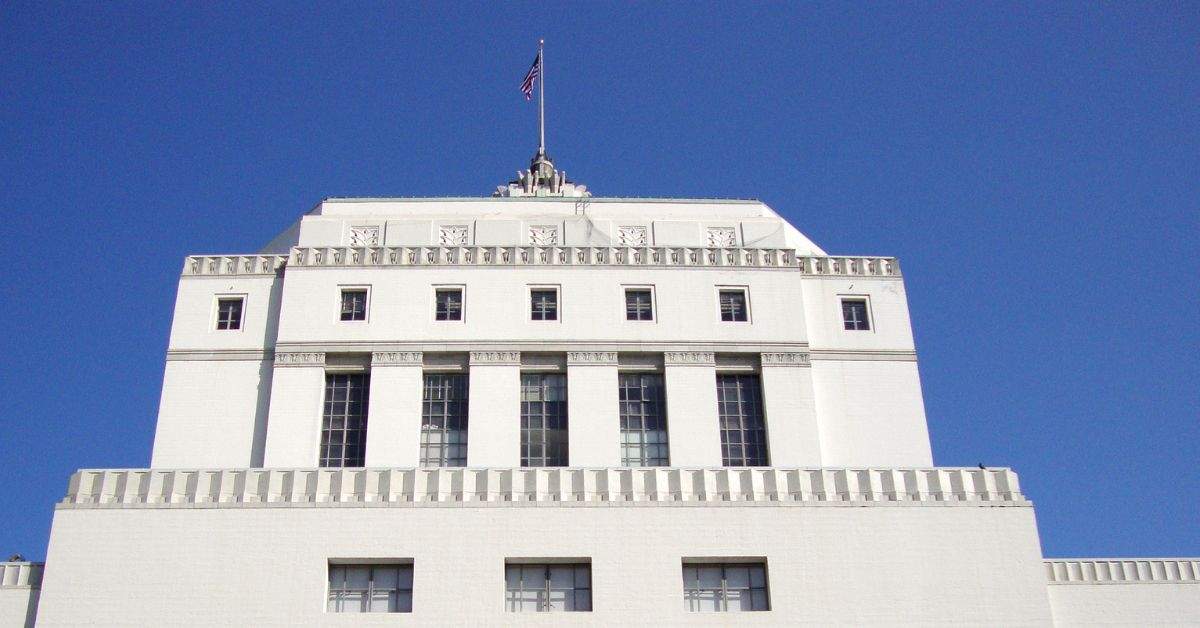In this article, we’re taking a closer look at eight specific eFiling processes you’ll encounter as you use eFiling in civil cases.
Straight from the Court, here are some guidelines to help you successfully file your documents electronically.
1. One lead document per transaction
When you file a document, or group of documents, in one single submission through your EFSP, the Court considers this a transaction. It’s important to know that you cannot submit more than one lead document per transaction in Los Angeles Civil.
For example, you will not be able to submit two motions or submit a cross-complaint and an answer in one transaction. Instead, each lead document must be filed in separate transactions.
Supporting documents can be filed together in the same transaction as the lead document that they reference.
Remember, per CA Code of Civil Procedure Section 428.50(a), you must file any cross-complaint against any of the parties who filed a complaint against you before or at the same time as filing an answer to the opposing party’s complaint. Filing cross-complaints with an answer will create an error in the system, and your documents may be rejected. Instead, you’ll place two separate transactions, first one for the cross-complaint and then one for the answer.
2. Jury Fees
Each court has a specific procedure when it comes to paying jury fees, and Los Angeles Civil will be no exception. When you file your pleading, you’ll need to pay the initial fee for the jury demand by selecting the “Notice of Deposit for Jury” filing document name from the drop-down menu of document types during the eFiling process. And remember: at One Legal, we always disburse your court filing fees upfront on your behalf.
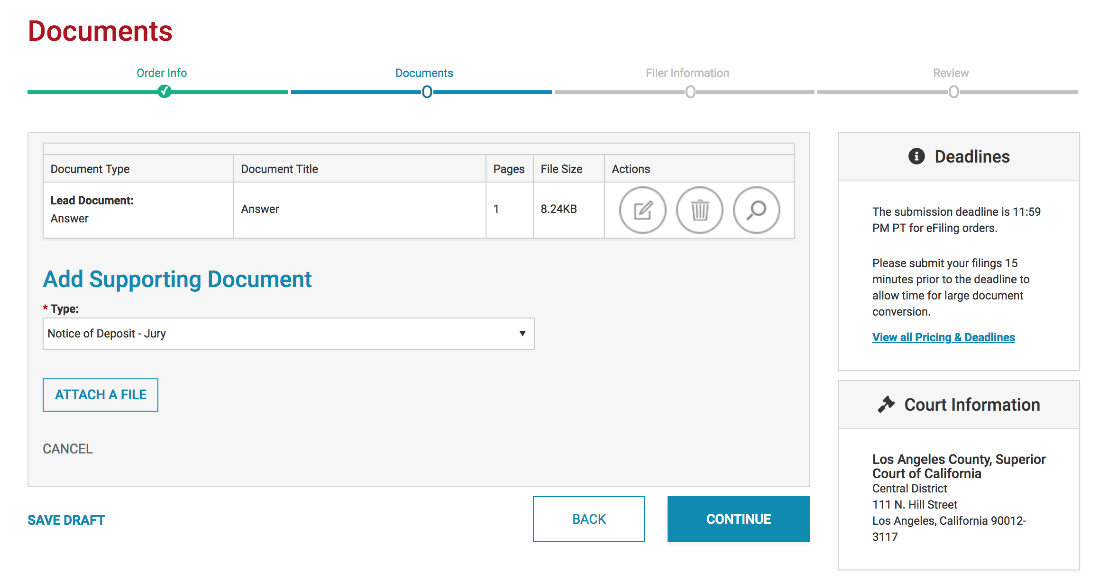
Definition: Filing document name
A Filing Document Name refers to the type of filing (e.g., answer, demurrer, motion, etc.) and is used by your EFSP to properly designate the document(s) upon submission.
It’s important to always use the correct filing document name to help determine the appropriate fee and court workflow for your filing.
3. Fee waivers
If you or your client is eligible for a fee waiver, both the fee waiver application and the initiating document should be submitted in the same transaction.
Either the complaint or the petition will be processed at the same time as the fee waiver application.
When filing your case initiation on One Legal, you indicate your filing party’s fee waiver eligibility after you’ve added the Plaintiff.
This step will take place on the Case Participants screen:
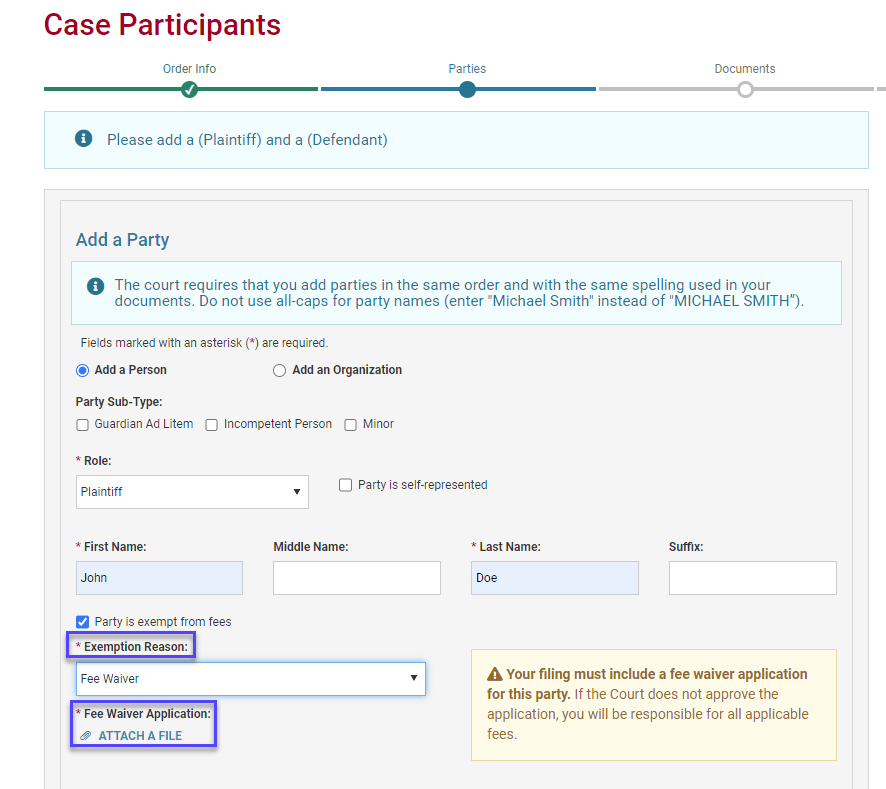
If you indicate the filing party is exempt because they are representing a government agency, no further action is needed. If you select fee waiver, One Legal will then prompt you to upload the appropriate document, as seen in the following image:
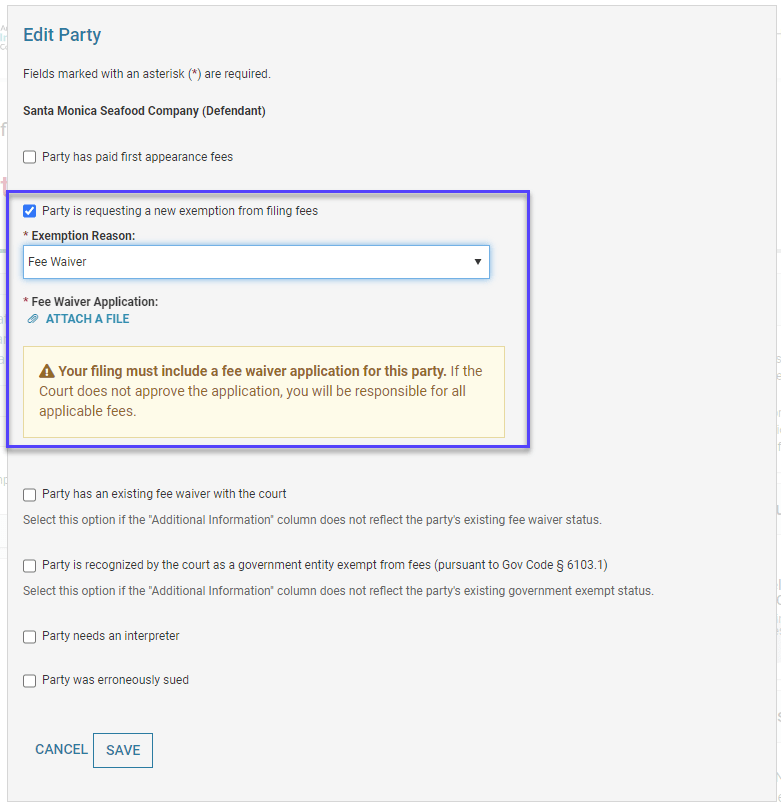
This is also true when a filing party is making a first appearance on an existing case.
4. Proposed orders
All proposed orders must be submitted as PDFs. Although CRC 3.1312 requires that a Word version also be submitted, the Court has indicated that they will countermand this requirement via a General Order (TBA).
If submitting a proposed order with motions, applications, or other documents, all of the documents can be submitted in the same transaction. However, make sure that the order is a separate PDF.
Once your proposed order is reviewed and signed by a judicial officer, the filed order will be transmitted back to you electronically and can be viewed, downloaded, and/or printed from your One Legal account.
There you have it: four need-to-know guidelines that will put you and your legal team on the road to eFiling success in Los Angeles. Next week, we’ll review how you can make the best use of the voluntary eFiling period and be ready well in advance of the mandates.
By now, you’ve prepared for the basics of eFiling and EFSPs. In previous posts, we’ve talked about the best practices for preparing legal documents for eFiling processes as well as what to expect from the Court once you’ve filed. You’ve also learned some detailed guidelines on lead documents, jury fees and waivers, and proposed orders.
Now, let’s take a closer look at four more specific eFiling processes you’ll encounter as you use eFiling in civil cases.
5. Exemptions and how to file them
Mandatory eFiling is here for the majority of filings, but not every document can be eFiled. The Court has identified the following documents as exempt from eFiling in Civil case types:
- Peremptory challenges or challenges for the cause of a judicial officer
- Bonds/undertaking documents
- Trial and hearing exhibits
- Lodged documents (Notice of Lodgment must be eFiled, though)
These documents can be submitted for filing in the Clerk’s Office of the Civil Division between the office hours of 8:30 a.m. and 4:30 p.m. or by mail. If you choose to mail your exempt documents, be sure to check lacourt.org for the correct courthouse address.
However, One Legal can help you with exempt document filing as well as eFiling. Select that option, and we’ll print, review, prepare, and deliver your exempt document to the courthouse for you.
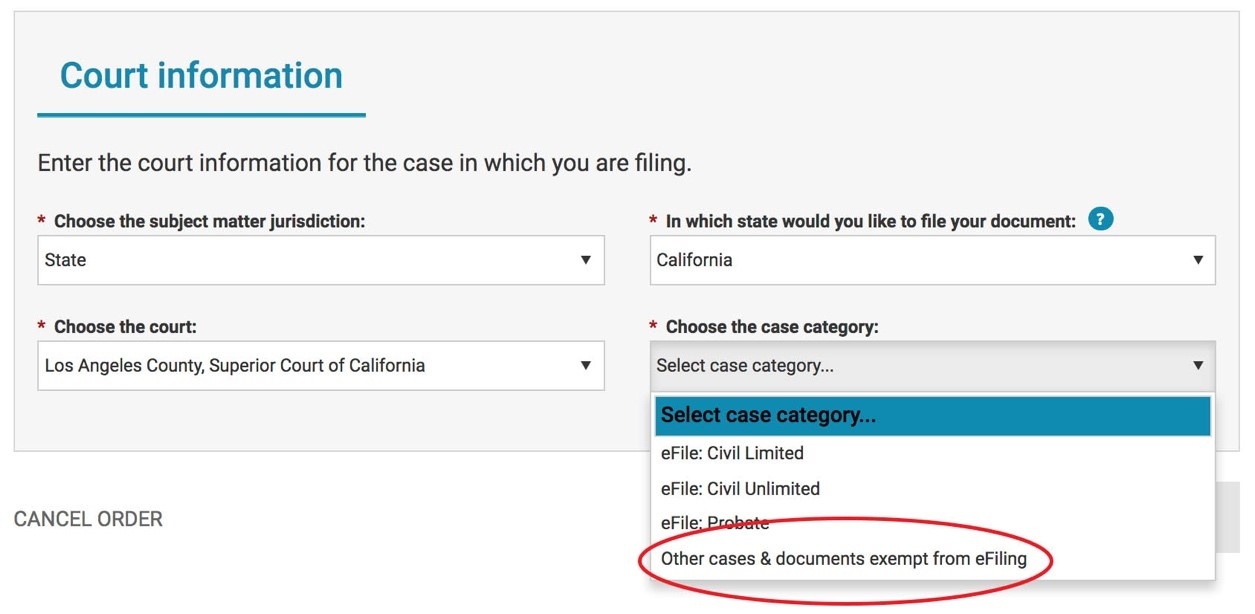
6. Courtesy copies
Speaking of printed documents, courtesy copies — delivered in paper format to the courthouse as well as eFiled — are required in certain instances.
The Court has identified the following documents as ones that will require a courtesy copy:
- Any printed document required pursuant to a Standing or General Order
- Pleadings and motions (including attachments such as declarations and exhibits) of 26 pages or more
- Pleadings and motions that include points and authorities
- Demurrers
- Anti-SLAPP filings, pursuant to Code Civ. Proc., § 425.16
- Motions for Summary Judgment/Adjudication
- Motions to Compel Further Discovery
- Opposition to an ex parte application
Also, according to the General Order Re: Mandatory Electronic Filing for Civil, nothing precludes a Judicial Officer from requesting a courtesy copy of other additional documents.
What’s important to remember is that you must submit proof of electronic along with your courtesy copy. Since courtesy copies can only be delivered to the courtroom during business hours, you’ll need to factor that in as you plan your eFiling.
According to the Court, courtesy copies for filings with a hearing date of two days or less shall be delivered to the courtroom by 4:30 p.m. the same business day if the electronic filing is submitted with the court prior to that time.
If you submit your electronic filing after 4:30 p.m., you’ll need to deliver the courtesy copy to the courtroom by 10 a.m. the next business day.
One Legal can take care of both your eFiling and courtesy copy requirements. Simply add a courtesy copy delivery to your eFiling order as you file.
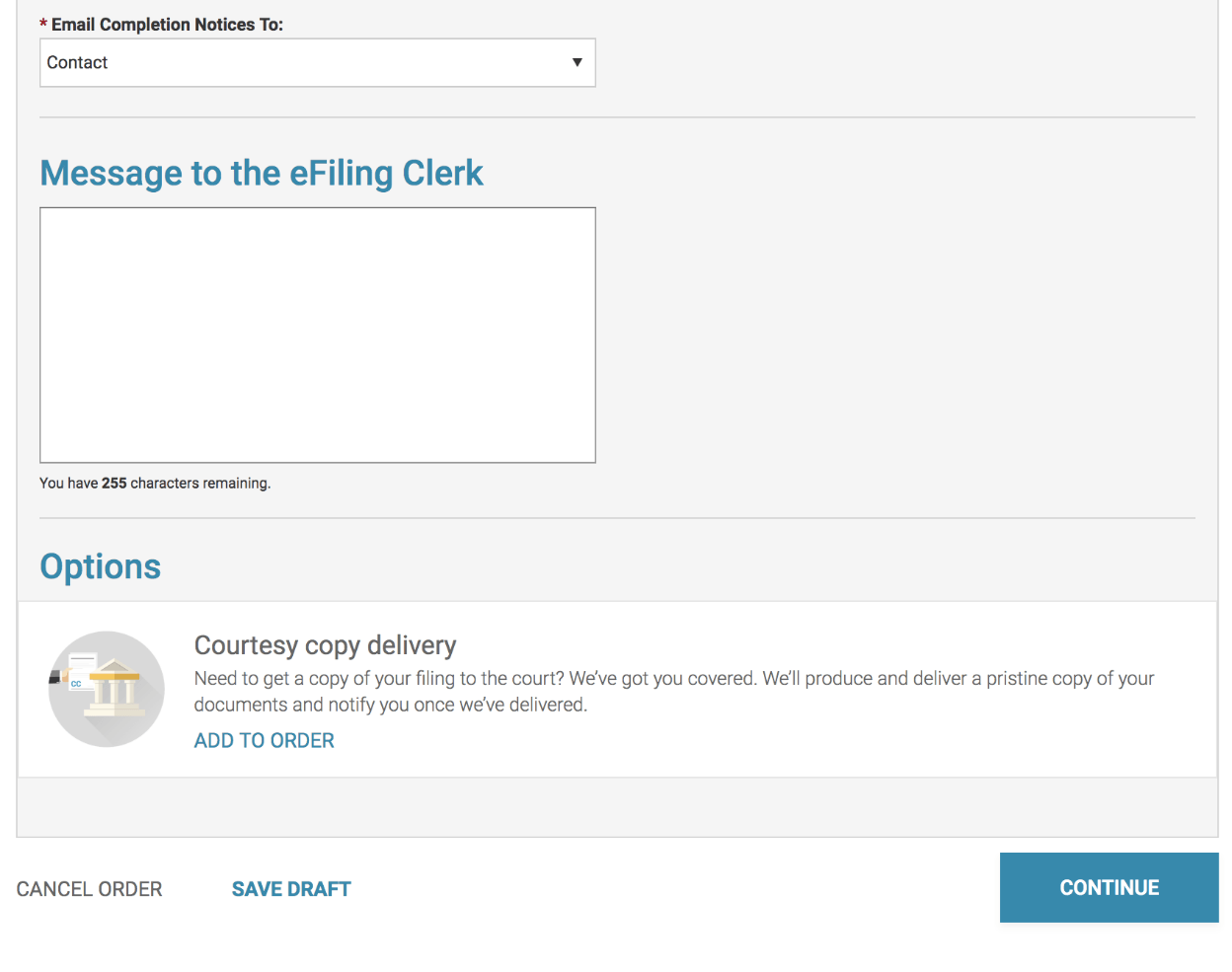
To ensure the quickest delivery of your courtesy copy, be sure to submit your eFiling documents to us in the morning. We’ll then prepare your printed courtesy copy, along with the required proof of electronic filing, and deliver it to the courtroom.
For the fastest service, you’ll need to select our Urgent Delivery in order for us to get your documents to the court timely.
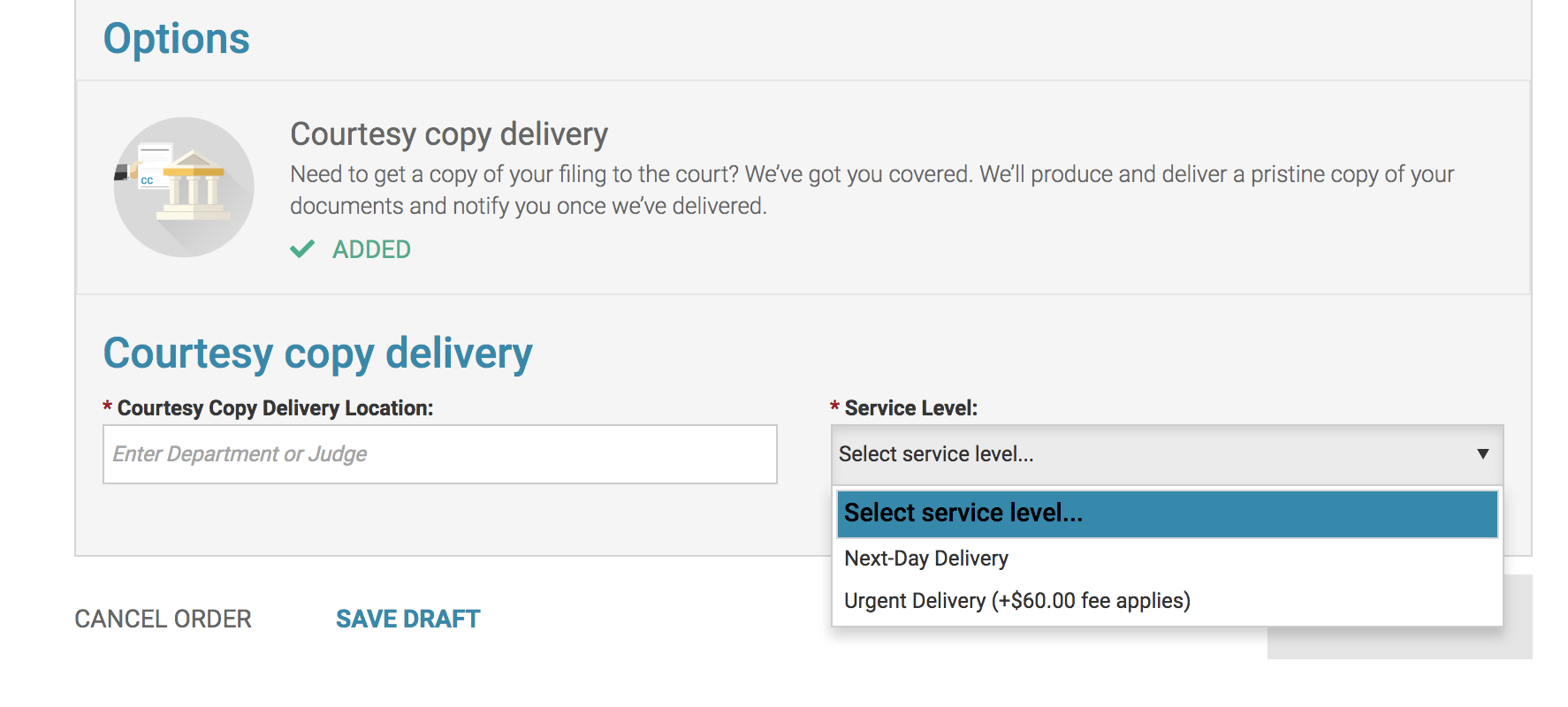
Remember: If you are placing a stand-alone courtesy copy order with us, you’ll need to provide the court transaction number in your special instructions or provide us with a filed endorsed copy that includes the court transaction number on it.
7. Filing ex parte documents
Timing is vital when eFiling ex parte documents, too. Ex parte applications must be eFiled no later than 10:00 a.m. the day before the ex parte hearing.
Written opposition to an ex parte application must be eFiled no later than 8:30 a.m. on the day of the ex parte hearing. According to CRC 3.1206, service of ex parte documents must be done at the first reasonable opportunity.
You’ll need to properly identify your document as “ex parte” to ensure that it will be expedited by the Court. Other important court rules to remember:
- Opposition to an ex parte application that is eFiled by 4:00 p.m. on the same day the ex parte is filed does not require a courtesy copy.
- Opposition to an ex parte application that is eFiled after 4:00 p.m. requires that a courtesy copy be brought to court the day of the ex parte hearing.
- The proposed order shall be included as a separate document in the same envelope as the ex parte application and brought to court on the morning of the ex parte hearing.
Remember: your courtesy copy will also need proof of electronic submission.
8. Filing documents under seal
According to Court FAQs, filers in Los Angeles Civil may submit a document “conditionally under seal” only if it’s a new case filed pursuant to CCP 482.050 or “Whistle Blower/False Claims” case, will initially be sealed if the “under seal” option is selected.
In One Legal’s workflow, there will be a checkbox for you to select “conditionally sealed” and then submit for clerk review at the court.
If the court clerk determines that the document is not to be sealed, they will remove the check, and your document will be publicly viewable like any other document.
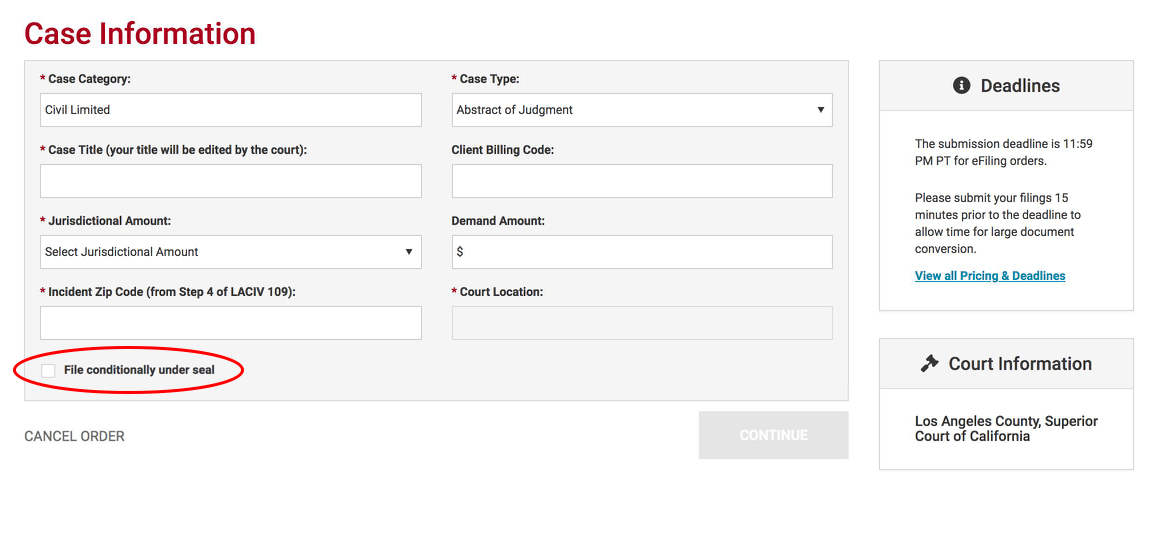
Conclusion
In conclusion, eFiling in Los Angeles civil cases necessitates a comprehensive understanding of crucial procedures.
We’ve highlighted essential aspects, such as the limitation of one lead document per transaction, the intricacies of jury fees, fee waivers, and the submission of proposed orders in PDF format for eFiling processes for the LASC.
Exemptions, courtesy copies, the protocol for filing ex parte documents, and the conditional submission of documents under seal are pivotal considerations.
As legal pros navigate these eFiling processes, whether you’re new to it or not, adherence to these detailed processes will undoubtedly contribute to a seamless and successful integration into the eFiling landscape in Los Angeles.

